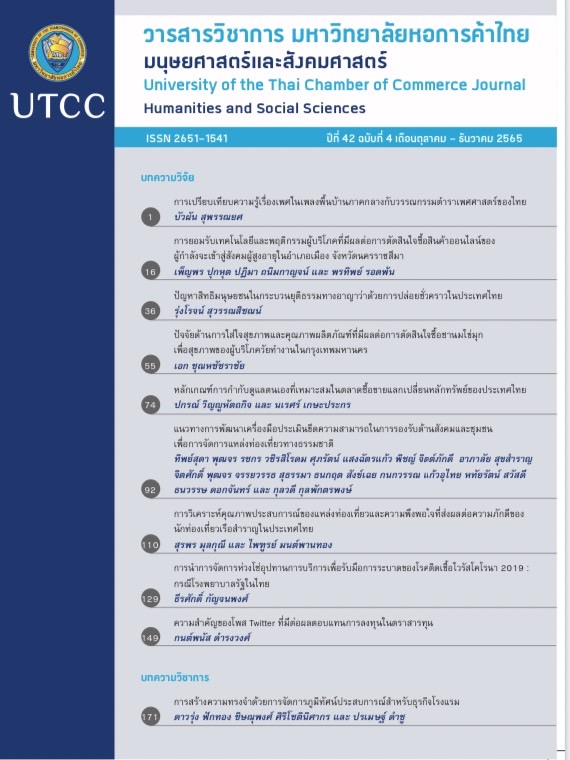A Comparison of Knowledge on Sexual Intercourse in Folk Song of Central Region and Sexology Textbooks
Main Article Content
Abstract
The purposes of this paper were to select the knowledge on sexual intercourse from the “performance texts” of folk song of Central region which were oral data and field data collected during 2016 – 2017 in the central region area; and to compare the knowledge on sexual intercourse in Central-region folk song and that in 6 sexology textbooks which were compiled
and studied in a research project entitled “Central Thai Traditional Textbooks and Monographs on Sexology: Revealing the Secret to Knowledge” by using folklore and literary study methodologies. The result found that there were 35 issues regarding sexual intercourse in folk songs relevant to those in sexology textbooks. These issues could be categorized into 3 groups: 1) sexual beliefs, i.e. the belief on predicting the size of female genitalia and physiognomy; 2) sexual traditions, i.e. manners and behaviors implying sexual intercourse; and 3) sexual knowledges, i.e. copulation positions and sexual enhancement herbs. The presentation techniques of sexual knowledges in folk songs could be found in 2 ways: 1) allusion; 2) allegory which aimed to show off rhetorical proficiency and wit rather than directly focusing on knowledges. The result of this study obviously indicated that sexual knowledges had long existed in Thai society particularly among folk people. Such knowledges were passed on so pervasively that they were taken to use as a comic gag in the performance, which caused understanding and sense of humor among the audience.
Article Details

This work is licensed under a Creative Commons Attribution-NonCommercial-NoDerivatives 4.0 International License.
ลิขสิทธิ์ของบทความ
ผลงานที่ได้รับการตีพิมพ์ถือเป็นลิขสิทธิ์ของมหาวิทยาลัยหอการค้าไทย ห้ามมิให้นำเนื้อหา ทัศนะ หรือข้อคิดเห็นใด ๆ ของผลงานไปทำซ้ำ ดัดแปลง หรือเผยแพร่ ไม่ว่าทั้งหมดหรือบางส่วนโดยไม่ได้รับอนุญาตเป็นลายลักษณ์อักษรจากมหาวิทยาลัยหอการค้าไทยก่อน
References
กุหลาบ มัลลิกะมาส. (2528). ระเบียบวิธีศึกษาคติชนวิทยา. ใน เอกสารการสอนชุดวิชาภาษาไทย 8: คติชนวิทยา สำหรับครู, ล.2. นนทบุรี: มหาวิทยาลัยสุโขทัยธรรมาธิราช.
บัวผัน สุพรรณยศ. (2563). เพลงพื้นบ้านภาคกลาง: ศิลปะการสอนเพศศึกษาแบบชาวบ้านไทย: รายงานวิจัย. นครปฐม: มหาวิทยาลัยมหิดล, คณะศิลปศาสตร์.
พนม เกตุมาน. (ม.ป.ป.). การสอนเพศศึกษา ตามพัฒนาการทางเพศ. สืบค้นเมื่อ 17 สิงหาคม 2559,จาก https://www.psyclin.co.th/new_page_50.htm
พูนพิศ อมาตยกุล. (2527). เพศสัมพันธ์ในวรรณคดีไทย. ภาษาและวัฒนธรรม, 4(2), 14-25.
ภารดีบุญเพิ่ม. (2544). การสอนเพศศึกษาของครอบครัวที่มีบุตรวัยรุ่น (วิทยานิพนธ์ปริญญามหาบัณฑิต ไม่ได้ตีพิมพ์). มหาวิทยาลัยขอนแก่น.
รื่นฤทัย สัจจพันธ์. (2560). ความรู้ทั่วไปทางภาษาไทย ตอนที่ 3 วรรณคดีไทย (พิมพ์ครั้งที่ 7). กรุงเทพฯ: มหาวิทยาลัยรามคำแหง
สมบัติสมศรีพลอย. (2559).กลอนแดง: วัจนกรรมบริภาษยอกย้อนในเพลงอีแซว.วารสารมหาวิทยาลัยศิลปากร, 36(2), 113-126.
สุกัญญาสุจฉายา. (2523). เพลงปฏิพากย์: การศึกษาในเชิงวรรณคดีวิเคราะห์ (วิทยานิพนธ์ปริญญามหาบัณฑิต ไม่ได้ตีพิมพ์). จุฬาลงกรณ์มหาวิทยาลัย, กรุงเทพฯ
สุกัญญา สุจฉายา (บรรณาธิการ). (2561). ไขความลับวรรณกรรมตำราเพศศาสตร์. นครปฐม: มหาวิทยาลัย มหิดล, คณะศิลปศาสตร์, โครงการวิจัย“วรรณกรรมตำราเพศศาสตร์ของคนไทยภาคกลาง: ไขความลับเป็นความรู้”.
สุคนธ์แสนหมื่น. (2549). การศึกษาเพลงปรบไก่ดอนข่อย เพชรบุรี(ปริญญานิพนธ์ปริญญามหาบัณฑิต ไม่ได้ตีพิมพ์). มหาวิทยาลัยศรีนครินทรวิโรฒ, กรุงเทพ ฯ.
อานนท์กาญจนโพธิ์. (2554). เพลงปรบไก่: การละเล่นสมัยอยุธยาที่หยาบคายที่สุดของไทย. เอกสารประกอบงานเกริกวิชาการ, 3 กุมภาพันธ์ 2554.
เอนก อารีพรรค, และสุวัทนา อารีพรรค. (2525). เรียนรู้เรื่องเพศ. กรุงเทพฯ: จุฬาลงกรณ์มหาวิทยาลัย.
Suphanyot, B. (2007). Sexuality in Thai folk songs. Manusya: Journal of Humanities, 10(1), 92-101. Retrieved from http://www.manusya.journals.chula.ac.th/wp-content/uploads/2021/06/7.Buaphan_92-102.pdf

